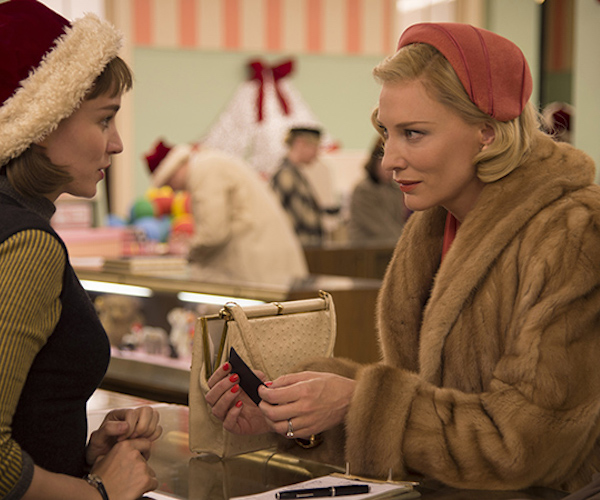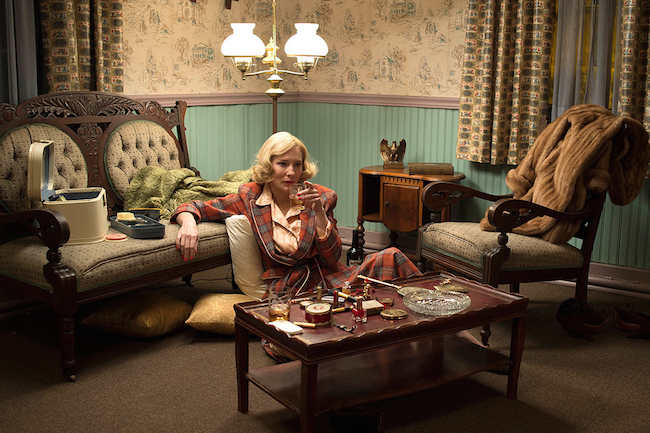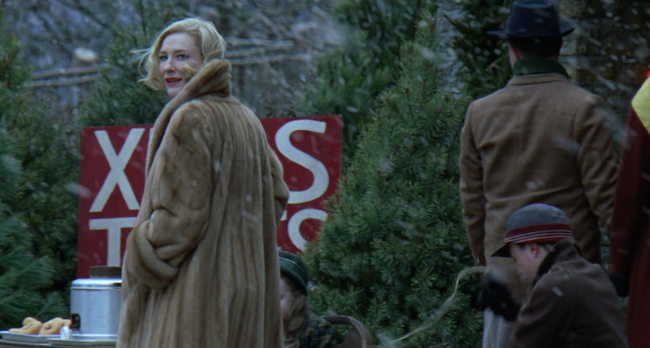Film Commentary: Blink a Bright Red and Green — “Carol’’’s Holiday Charm
A guide to the symbolic color odyssey that will keep you on your toes if you choose to see Carol more than once (and I’m thinking you will).

Rooney Mara and Cate Blanchett in “Carol.”
By Peg Aloi
Add Todd Haynes’ midcentury love story Carol to your list of favorite Christmas-themed films. Just as Far From Heaven told its story with lush autumn landscapes (and a dazzling symbolic color structure offered as an homage to Douglas Sirk and Technicolor), Carol (screening at the Kendall Square Cinema) uses a muted and yet bold palette heavy with red and green that gives subtle nuance and depth to a passionate romance. Though most viewers won’t be focused on color palettes while watching a film so rich with other delights: namely the expressive, white-hot performances of Cate Blanchett and Rooney Mara, and stunning period backdrops set in Manhattan, New Jersey, Chicago and Iowa, among other places (although oddly, most of the film is shot on location in Cincinnati).
The film’s opening scene briefly establishes a relationship of unknown breadth between Carol Aird (Blanchett) and Therese Belivet (Mara); they’re seated in a restaurant and are interrupted by a young man who recognizes Therese and offers her a ride to a party. They part hastily, Carol assuring Therese she has calls to make before dinner, and Therese gathers her coat. En route to the party, she turns her head as if wishing to see what is behind her. A warm red light washes over the rain-misted window, and she sees a couple crossing the street. Their movement is slowed by the camera, languid, dreamy; the woman has pale blonde hair the shade and shape of Carol’s. We hear a siren in the distance and see blurred red lights blink haltingly in the background.
Then we see a flash of red and the siren becomes a metallic whirring sound: an electric train set with red-painted figures and tiny streetlights blinking. The train enters its tin tunnel, and we know we’re in symbolic cinema territory; or, as George Carlin once suggested, you don’t have to be Fellini to figure this out. We see Therese wearing a blood-red Santa hat, working behind a department store counter, looking across the room at Carol, wearing a red beret and shopping somewhat listlessly. Therese stands primly at the counter; her wide eyes follow Carol’s movements, her lips pursed, and their eyes meet. Cut to: Therese waking up in her apartment, getting ready for work on a winter morning, green curtains at the window, a red garment tossed over a chair. Her boyfriend stands on the street below with his bicycle, a plastic ball that is half red and half green on the ground near him.
Yes, I am not kidding; the ball is half red and half green. Thus begins this symbolic color odyssey that will keep you on your toes if you choose to see this film more than once (and I’m thinking you will). This excellent interview in Variety with cinematographer Ed Lachman (who has already garnered abundant praise for this film, including a Best Cinematography Award from the Boston Society of Film Critics) discusses Carol as a “stylistic foil” to Far From Heaven. It’s a fertile comparison, given the visual excesses of both. But where Far From Heaven was drenched in color (given its Sirkian aspirations), Carol is often understated. Technicolor was used as a visual reference for the former, while Ektachrome informed the latter. The interviewer asks Lachman to expound on the “representational colors” of the film, to which he replies that the colors are “more soiled and muted” with “more magentas, yellows and green.”

Cate Blanchett in “Carol.”
Those who enjoy Haynes’ dramatic use of color-as-psyche in Far From Heaven (think of Cathy’s pale lavender scarf, the sickly green walls of the police station after Frank is arrested) may also find Carol’s use of red and green intriguing. Where yellowish-green was used in Far From Heaven to denote the shameful world of homosexuality, in Carol it seems to represent the often oppressive world of the mundane: it is what must be accepted, if isolating. Fittingly, red signifies its emotional opposites: intrigue, surprise, passion. The story takes place in the week before and after Christmas, and along with the rich visual signifiers of the holiday (lights, decorations, trees and snow), this clever color binary defines the film’s narrative arc. Indeed, the only burst of Christmas music we hear (in a soundtrack of sultry period pieces and Carter Burwell’s haunting score) is Perry Como’s jaunty version of “Silver Bells” which includes the lyrics “Strings of street lights, even stop lights, blink a bright red and green.”
We see that red in pivotal scenes involving Carol and her bewitching effect on Therese, as when the department store scene plays out in more detail after Therese’s initial flashback. We again see Therese gazing at Carol, and we understand that Our Story begins here, on the day they met — the lingering looks, their careful, coded conversations as they explore what they may be to one another. Carol approaches the counter, hat and scarf matching her meticulously-lacquered nails, to ask for a doll for her daughter. Carol engages her in an almost playful conversation, asking what kind of toys she liked as a girl. Carol says she enjoys trains, and Carol orders one. Visibly flustered by the older woman’s poise and, apparently, by the interest she shows in a shopgirl, Therese watches as Carol walks away, then turns and gestures with her hand saying “I like the hat,” flirtatiously dropping her gaze in a smoldering sweep of eyelashes that happens so quickly we’re not quite sure it happens at all. Like Therese, we’re enchanted.
But how does a woman who exudes such alluring confidence manage to forget her expensive leather gloves on the counter? At the end of the workday, Therese stands in front of her locker, eyes shut, the closing bell ringing shrilly, the pale green walls boxing her in. That night, after a date with her boyfriend Richard (Jake Lacy) where she breezily ignores his advances, and is given a 35mm camera by one of his friends, she fondles the gloves and sales slip with Carol’s address, and ventures out to the mailbox in the pre-dawn light.
Leather gloves are Carol Aird’s calling card (she has red ones, too, and periwinkle blue!), and it’s tempting to think she left them behind on purpose. She calls to thank Therese, inviting her to lunch. They sit on red leather seats and Carol airily orders creamed spinach and a dry martini: the light meal of a wealthy suburbanite on a shopping jaunt in the city. Therese orders the same thing. Offering her a cigarette, her glance considering if Therese might follow her lead in almost anything, Carol offers a careful personal question: does Therese live alone? Does she want to marry her boyfriend? “I can’t even decide what to have for lunch,” she demures. “What a strange girl you are,” Carol muses.
Carol invites Therese to visit her on a Sunday (the winter solstice, we see in Therese’s datebook), picking her up in Manhattan in a mushroom-grey Packard. Their car ride is a sensual odyssey; they glance at each other’s hair and clothing, and the radio’s music is distant and foggy. The light shimmers with surreal colors as they travel through a tunnel. (Yes, another tunnel) Lachman and Haynes make breath-catching art of these transitional scenes, heady strands layered with desire and future memory.

Cate Blanchett and Xmas tree in “Carol.”
The women arrive at a Christmas tree lot, the dreamy travelogue colors of their journey shifting to stark winter daylight: deep green trees are arranged beneath red banners and sparse snowflakes are falling. Therese’s pale cheeks glow from the cold and her fingers, clutching the camera as she snaps a candid photo of Carol, are red. They spend an idyllic day in Carol’s Ridgewood mansion, with tree trimming, tea, and a heated moment where Carol lays her hands on Therese’s shoulders as she plays the piano. But the mood is banished with the unexpected arrival of Therese’s estranged husband Harge (a wonderful Kyle Chandler). After a tense drive to the train station, we again see Therese’s normally stoic face red with tears, this time with heat, not cold, crying helplessly, sloppily, in public (as you do when your heart is heaving with confusion and desire).
Carol apologizes and soon after the two women embark on a cross-country car trip to Chicago over Christmas. The trip is replete with gorgeous set pieces, including my favorite scene in the film, where the two drink whiskey as they sit on the floor around a low table covered with cosmetics, sampling lipsticks while holding hand mirrors. Therese applies perfume to Carol’s wrists, which she applies to her neck, encouraging Therese to smell it there. The electric charge of their fleeting touch seems to pulse through the room — a “Presidential suite” in some Midwest hotel. Carol breaks the awkwardness of the moment by raising her glass “To President McKinley!” and both women crack up. Each passing day and each new hotel with twin beds brings them closer to an inevitable consummation. The women celebrate New Year’s Eve in a dingy motel in Iowa, in each other’s arms.
It wouldn’t do to spoil the film’s plot with any more of my chromatic musings, but it seems important to say that the film ends nearly where it begins, with Carol and Therese facing each other over a table in a restaurant, the picture of respectability, in a story where accusations of immoral conduct and aberrant behavior (denoting the stigma of same-sex love in 1950s America) are tossed with earnest haste, like warning flares. The final scene occurs in yet another restaurant, warm with burnished wood paneling and glasses of red wine. Small lamps with red shades provide bright spots of color in the crowded dining room, as one of the women weaves her way towards the other, the red glowing lights like beacons in the fog.
Peg Aloi is a former film critic for The Boston Phoenix. She has taught film studies for a number of years at Emerson College and is currently teaching media studies at SUNY New Paltz. Her reviews have appeared in Art New England and Cinefantastique Online, and she writes a media blog for Patheos.com called The Witching Hour.
Tagged: Carol, Cate Blanchett, Ed Lachman, Peg Aloi, Rooney Mara

[…] could go on and on about these films, and trust me, people have (here’s a take on the use of color in Carol, and here’s one about the costuming). What I love most about […]